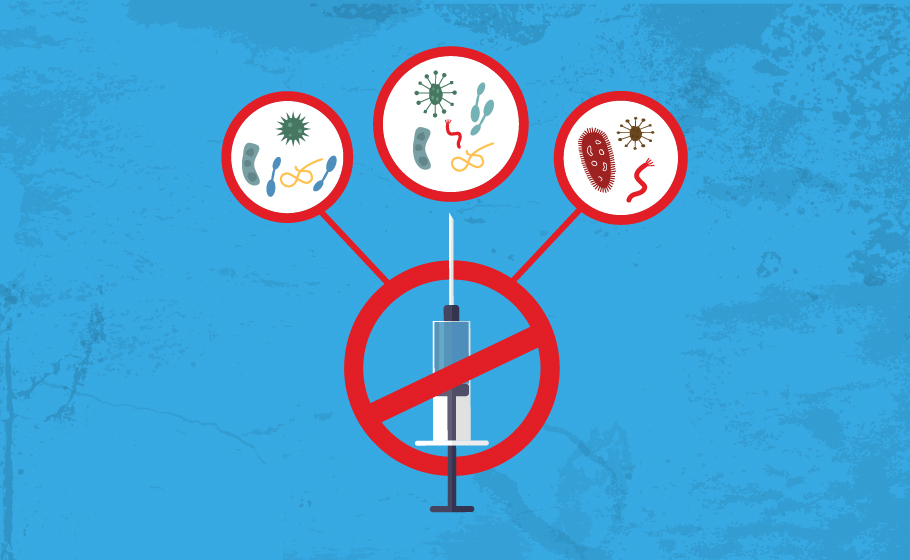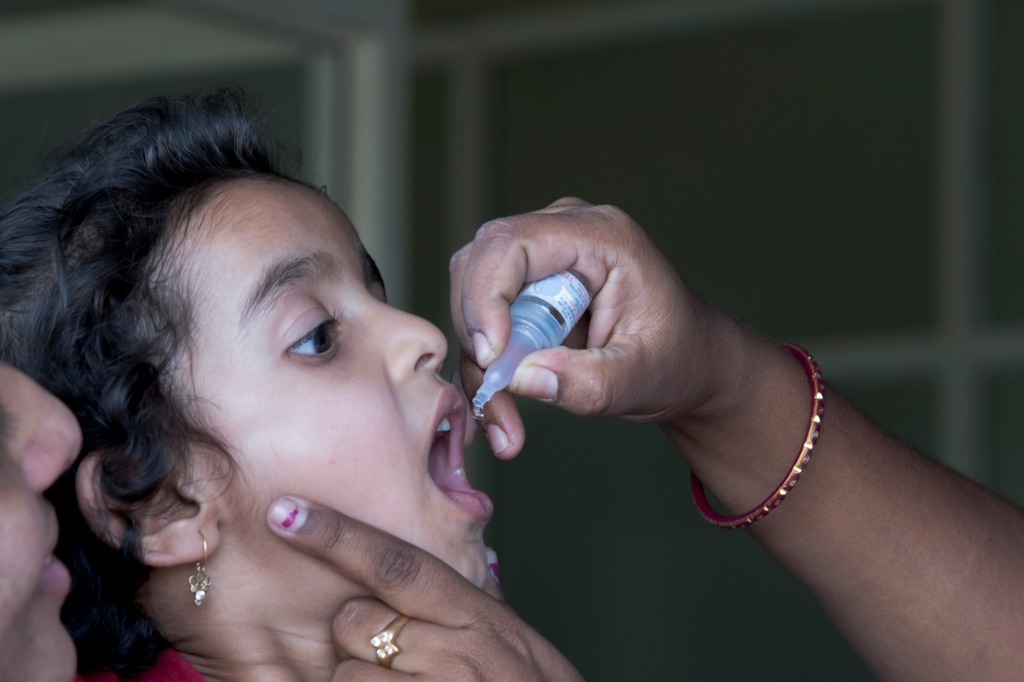
- Home
- News
- Analysis
- States
- Perspective
- Videos
- Education
- Entertainment
- Elections
- World Cup 2023
- Features
- Health
- Business
- Series
- Economy Series
- Earth Day
- Kashmir’s Frozen Turbulence
- India@75
- The legend of Ramjanmabhoomi
- Liberalisation@30
- How to tame a dragon
- Celebrating biodiversity
- Farm Matters
- 50 days of solitude
- Bringing Migrants Home
- Budget 2020
- Jharkhand Votes
- The Federal Investigates
- The Federal Impact
- Vanishing Sand
- Gandhi @ 150
- Andhra Today
- Field report
- Operation Gulmarg
- Pandemic @1 Mn in India
- The Federal Year-End
- The Zero Year
- Premium
- Science
- Brand studio
- Home
- NewsNews
- Analysis
- StatesStates
- PerspectivePerspective
- VideosVideos
- Entertainment
- ElectionsElections
- Sports
- Loading...
Sports - Features
- BusinessBusiness
- Premium
- Loading...
Premium

Are vaccination fears hurting immunisation efforts?
Experts too blame the ‘anti-vaccination movement’ for the huge drop in immunisation. WHO, earlier this year, too has pointed out that the anti-vaccine movement is one of the worst health threats in 2019.

“I never exposed my daughter to any kind of vaccination. She is perfectly alright now,” says writer Nakkeeran. His angst against the government’s immunisation drive is not unfounded. There have been several cases of abnormalities and deaths caused by vaccinations, he says. Well-known paediatrician Jacob Puliyel had written in the Sunday Guardian that there were 237 deaths in...
“I never exposed my daughter to any kind of vaccination. She is perfectly alright now,” says writer Nakkeeran. His angst against the government’s immunisation drive is not unfounded. There have been several cases of abnormalities and deaths caused by vaccinations, he says.
Well-known paediatrician Jacob Puliyel had written in the Sunday Guardian that there were 237 deaths in the country as of August 2016 within 72 hours of administering pentavalent vaccine, which is given for five life threatening diseases such as Diphtheria, Pertussis, Tetanus, Hepatitis B and Haemophilus influenzae type B (Hib).
In a study, he found that between 2000 and 2017, around 4.91 lakh persons were paralysed not because of ‘wild polio’ but because of polio-induced Acute Flaccid Paralysis (AFP). He also cast aspersions on the Rotavirus vaccine.
In 2017, the Madhya Pradesh High Court ordered the state government to give compensation to Devilal, a 26-year-old polio patient, whose lower limbs got affected due to polio vaccine administered to him 22 years ago.
“That was the first case in the country in which compensation has been given in a vaccine-caused disease,” says Prema, a homeopathy practitioner.
The reports gave weight to speculations and conjectures about the government’s vaccination drives. Activists like Nakkeeran, Prema and physicians like V Pugazhenthi, who are closely associated with Poovulagin Nanbargal’, an organisation working towards environment protection, known for raising genuine questions, became torchbearers of the anti-vaccination campaign. Social media too caught fire, running unverified information, scaring people further.
Fight hits drive
The fear-mongering resulted in a resistance to immunisation. Many people decided to let their children’s lives take its own course.
This affected the Tamil Nadu government’s mass vaccination driver for measles and rubella (MR) in 2017 where thousands did not take up the immunisation.
Following that, Tamil Nadu fell in immunisation rankings in the country from the third place in 2015-16 to the ninth place 2017-18, according to a report released by NITI Ayog recently. The state government was able to achieve only 76.1 per cent immunisation in 2017-18, down from 82.66 per cent in 2015-16.
In January this year, people in Karnataka fell prey to misinformation spread on Whatsapp, and that caused the outbreak of Kyasanur Forest Disease or monkey fever.
In April this year, thousands of children did not get vaccinated in Mumbai and Delhi during a drive by the United Nations Children’s Fund (Unicef). The world body’s move was met with opposition from parents, who were scared of potential adverse effects of inoculation. Unicef officials blamed it on rumours being spread on WhatsApp.
Also read: A decade on, diphtheria raises its ugly head in Tamil Nadu again
Two months later, cases of diphtheria — an air-borne bacterial infection which affects the nose and throat of the children causing fever, sore throat or swelling in neck glands — broke out in 2018-19 from Chennai, Tirunelveli, Madurai, Tiruppur and Virudunagar districts of Tamil Nadu.
The state government swung into action and launched a mass vaccination drive. The anti-vaccination movement reared its head again. Debates arose over the side-effects and deaths. Anti-vaccination activists started voicing their fears and attacking the government for not explaining about the side effects.
“We are neither asking parents to go for vaccination nor stopping them from getting their children vaccinated. What we are asking is that the government bring out vaccination-related information, like side effects, in a transparent manner,” says Prema.
By late September, the government vaccinated 80 lakh children and pregnant women, but 50 cases had been reported and two children from Erode district had succumbed to the disease.
No science behind claims?
Experts blame the ‘anti-vaccination movement’ for the huge drop in immunisation. WHO, earlier this year, too has pointed out that the anti-vaccine movement is one of the worst health threats in 2019.
Dr Ezhilan, a government doctor supporting vaccinations, points to activists and says there is a need to check their background.
“Many a time, they are not doctors. Without any knowledge of medicine, they disseminate wrong information. In the name of fighting against corporatisation of healthcare industry, they unknowingly fight against vaccinations. For them the problem is private companies manufacturing the vaccines. I think if public sector companies manufactured vaccinations, they will support the vaccination drive,” he said.
Renowned virologist Jacob John of Christian Medical College, Vellore, under whose guidance polio eradication got a shot in the arm in the country, too pointed out that anti-vaccination activists have no data to prove their claims.

But Nakkeeran says whatever he has written was based on articles that appeared on top medical journals like Lancet.
“We didn’t write articles on our own. We referred many medical journals like Lancet, and based on facts, we raised our concerns. But we were termed as ‘pseudo scientists’.”
However, many of his citings and those of several activists’ are based on studies by discredited British physician Andrew Wakefield. In a 1998 study published in Lancet, Wakefield connected measles, mumps, and rubella vaccine with autism. The study was found to be flawed and Lancet withdrew the article and Wakefield lost his licence to practice medicine.
Nakkeeran has cited this article a few times while others have quoted another article that had Wakefield as co-author — ‘MMR and autism in perspective: The Denmark Story’, by Dr Carol Stott et al.
Despite that, Nakkeeran and others continued to write, since “no other allopathy doctors were ready to speak about the business that lies behind vaccination”.
Dr Jacob John says that parents who decide not to get their children vaccinated may fall prey to the anti-vaccination campaign. But apart from them, “nobody believes in the false campaign which are doing the rounds on social media,” he says, asserting that these vaccines are tested, confirmed and are being used all over the world.
“Child deaths are happening across the globe due to various reasons. In order to hide those deaths, the anti-vaccine campaigners attribute them to vaccinations,” he adds.
Ignorance and lack of interest
But besides the anti-vaccination movement, Dr K Kolandasamy, director of public health, Tamil Nadu, highlights the ignorance among current generation parents, which is a major challenge in achieving 100 per cent immunisation.
“They haven’t seen the extent of damage polio has caused, or other infections for that matter. Even doctors practising in the private sector are not giving due importance to these issues. Most of the private hospitals miss the vaccination schedules,” he says, adding that government hospitals along with paediatric associations, WHO experts, are conducting meetings in major cities to create awareness about the importance of vaccination.
This year, they had made it compulsory for children up to 17 years to get vaccinated for diphtheria, he said, adding that earlier, some resistance during earlier vaccination drives in Kerala and Tamil Nadu had caused the resurgence of the disease.
Also read: Fight vaccine hesitancy as contagious disease, UN meeting told
Dr Ezhilan also points out that there is bound to be inefficiency in the vaccination drive when the state government hands over healthcare activities to contract employees.
“There is so much shortage of medical practitioners in primary health centres. The people who are employed there under contract and working for a meagre salary, are not ready to reach out to the people. Because of this, full immunisation coverage gets stalled,” he says.
Dr Kolandasamy feels another reason why the state has been unable to achieve 100 per cent immunisation coverage is because of migrants. “It becomes a wearisome process to find them and administer vaccinations,” he says.
Herd immunity and lifestyle changes
Another reason behind the fall in immunisation could be the herd immunity mentality among people, wherein it is believed that if about 80% of people in a community are immunised, the rest 20% are unlikely to contract the disease and the virus has little chance of spreading.
However, Dr Raj Mohan, a paediatrician, says there is a possibility of the opposite of herd immunity happening when lesser percentage of the population is vaccinated.
“Most people think why should they vaccinate their children, as the disease is not common now. This causes lack of ‘herd immunity’ among people. This will also lead the children to be affected by diphtheria,” he says.
Dr G Ganesan, who creates awareness about vaccination through his writings, says any side-effects after vaccination is because of our lifestyle changes.
“Today’s infants have low resistance even from their birth. So, blaming vaccination programme for any of its side-effects is baseless. Last year, a community in Kerala averted getting vaccinated, citing their cultural norms. They got affected with diphtheria,” he recalls.
“There are no ethics followed in the business of manufacturing vaccines and there is a lot of politics around it. We need to oppose those things instead of opposing vaccination programmes,” he adds.
Numbers not true?
On the other hand, Dr Jacob John raises issues with the NITI Aayog’s report on immunisation. “It has been said that the study is based on wrong denominator. In Tamil Nadu, private hospitals also administer vaccination. Those numbers are not being taken into account. For instance, in CMC alone, we administer various immunisation programmes and on every day of every week, we vaccinate around 360-400 children. Those data are not getting into the national registry. In Kerala, data from the private sector is being added in the state registry. But I don’t think the same is being replicated in Tamil Nadu,” he says.
Dr Pugazhenthi, an anti-vaccination activist known for his fight against nuclear power plant in Kalpakkam in Kancheepuram district, too raises doubts over whether the numbers put out by the government is true.
Claiming that studies from Centre for Disease Control in the United States have shown that even before vaccination, many infectious diseases were kept under control, he said, “By providing good food, good water, good environment most of the infectious diseases can be controlled. But governments are not in a position to provide them. When we raise questions, government officials do not even reject our claims. And they call us people against science!”
Dismissing the repeated emphasis on “access to healthcare”, he said the need of the hour was to change the discourse to that of “quality of healthcare”.

